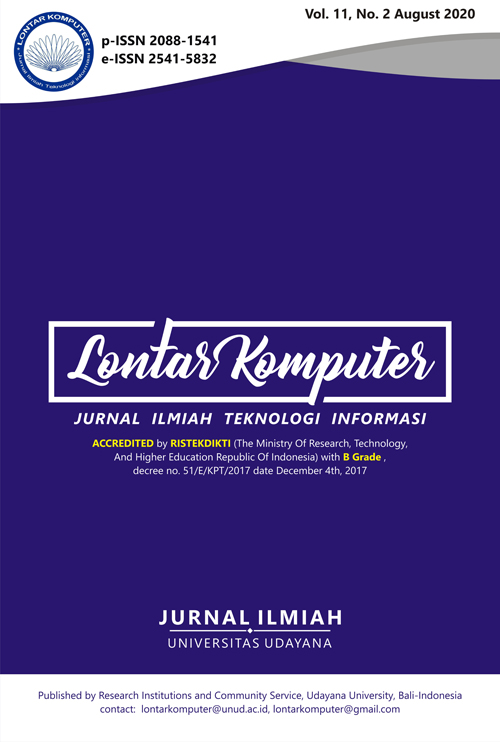A Feature-Driven Decision Support System for Heart Disease Prediction Based on Fisher's Discriminant Ratio and Backpropagation Algorithm
Abstract
Coronary heart disease included a group of cardiovascular, and it is a leading cause of death in low and middle-income countries. Risk factors for coronary heart disease are divided into two, namely primary and secondary risk factors. The need to identify characteristics or risk factors in heart disease patients by making the classification model. The modeling of heart disease classification to know how the system can able to reach the best prediction accuracy. Fisher's Discriminant Ratio is one of the methods for feature selection, which is used to get high discriminant features. While Backpropagation is one of the classification models to recognize patterns in heart disease patients. The experiment results showed that the accuracy of the classification model using 13 original features reached 92%. By reducing the features based on the score of the feature selection, then the lowest feature was removed from original features and left there were 12 features involved in the classification model which the accuracy increased to 93%. Furthermore, the results of determining the threshold (accuracy does not decrease continuously) and consider the effect of eliminating the lowest features that are considered quite fluctuating on accuracy. The accuracy reached 90% by eliminating the five lowest features and left eight existing features.
Downloads
References
[2] L. Soares-Miranda, D. S. Siscovick, B. M. Psaty, W. Longstreth Jr, and D. Mozaffarian, "Physical activity and risk of coronary heart disease and stroke in older adults: the cardiovascular health study," Circulation, vol. 133, no. 2, pp. 147–155, 2016.
[3] P. Zhang, X. Xu, X. Li, and others, "Cardiovascular diseases: oxidative damage and antioxidant protection," European Review for Medical and Pharmacological Sciences, vol. 18, no. 20, pp. 3091–3096, 2014.
[4] K. A. Wojtunik-Kulesza, A. Oniszczuk, T. Oniszczuk, and M. Waksmundzka-Hajnos, “The influence of common free radicals and antioxidants on development of Alzheimer’s Disease,” Biomedicine & Pharmacotherapy, vol. 78, pp. 39–49, 2016.
[5] U. Bhalani and P. Tirgar, "A Comparative Study for Investigation into Beneficial Effects of Ketoconazole and Ketoconazole+ Cholestyramine Combination in Hyperlipidemia and The Complications Associated With It.," Advances in Bioresearch, vol. 6, no. 4, 2015.
[6] J. L. Mega et al., "Genetic risk, coronary heart disease events, and the clinical benefit of statin therapy: an analysis of primary and secondary prevention trials," The Lancet, vol. 385, no. 9984, pp. 2264–2271, 2015.
[7] J. Bruthans et al., "Educational level and risk profile and risk control in patients with coronary heart disease," European Journal of Preventive Cardiology, vol. 23, no. 8, pp. 881–890, 2016.
[8] K. Uyar and A. Ihan, "Diagnosis of heart disease using genetic algorithm based trained recurrent fuzzy neural networks," Procedia Computer Science, vol. 120, pp. 588–593, 2017.
[9] "UCI Machine Learning Repository: Heart Disease Data Set." https://archive.ics.uci.edu/ml/datasets/Heart+Disease (accessed May 02, 2020).
[10] K. B. Nahato, K. H. Nehemiah, and A. Kannan, "Hybrid approach using fuzzy sets and extreme learning machine for classifying clinical datasets," Informatics in Medicine Unlocked, vol. 2, pp. 1–11, 2016.
[11] A. R. Pratama, M. Mustajib, and A. Nugroho, “Deteksi Citra Uang Kertas dengan Fitur RGB Menggunakan K-Nearest Neighbor,” Jurnal Eksplora Informatika, vol. 9, no. 2, pp. 163–172, Mar. 2020, doi: 10.30864/eksplora.v9i2.336.
[12] Mirwan, A. Nugroho, F. Hendarta, R. Hidayatillah, F. Hassan, and K. P. Nana, "Virtual Assistant Using Lstm Networks In Indonesian," in 2018 International Seminar on Research of Information Technology and Intelligent Systems (ISRITI), Nov. 2018, pp. 652–655, doi: 10.1109/ISRITI.2018.8864448.
[13] S. Jain, S. Shukla, and R. Wadhvani, "Dynamic selection of normalization techniques using data complexity measures," Expert Systems with Applications, vol. 106, pp. 252–262, Sep. 2018, doi: 10.1016/j.eswa.2018.04.008.
[14] M. F. Tresna, S. Iwan, and R. B. Ali, "Data Mining Approach for Breast Cancer Patient Recovery," EMITTER International Journal of Engineering Technology, vol. 5, no. 1, pp. 36–71, 2017.
[15] N. Borisagar, D. Barad, and P. Raval, "Chronic Kidney Disease Prediction Using Back Propagation Neural Network Algorithm," in Proceedings of International Conference on Communication and Networks, 2017, pp. 295–303.
[16] A. Wanto, A. P. Windarto, D. Hartama, and I. Parlina, "Use of Binary Sigmoid Function And Linear Identity In Artificial Neural Networks For Forecasting Population Density," International Journal of Information System and Technology, vol. 1, no. 1, pp. 43–54, 2017.
[17] B. M. Jadav and V. B. Vaghela, "Sentiment analysis using support vector machine based on feature selection and semantic analysis," International Journal of Computer Applications, vol. 146, no. 13, 2016.
[18] Z. Cömert and A.F Kocamaz, "Comparison of machine learning techniques for fetal heart rate classification," Acta Physica Polonica A, vol. 132, no. 3, pp. 451–454, 2017.
[19] L. Ali et al., "A Feature-Driven Decision Support System for Heart Failure Prediction Based on χ2 Statistical Model and Gaussian Naive Bayes," Computational and Mathematical Methods in Medicine, 2019, doi: 10.1155/2019/6314328.
The Authors submitting a manuscript do so on the understanding that if accepted for publication, the copyright of the article shall be assigned to Jurnal Lontar Komputer as the publisher of the journal. Copyright encompasses exclusive rights to reproduce and deliver the article in all forms and media, as well as translations. The reproduction of any part of this journal (printed or online) will be allowed only with written permission from Jurnal Lontar Komputer. The Editorial Board of Jurnal Lontar Komputer makes every effort to ensure that no wrong or misleading data, opinions, or statements be published in the journal.
 This work is licensed under a Creative Commons Attribution 4.0 International License.
This work is licensed under a Creative Commons Attribution 4.0 International License.























